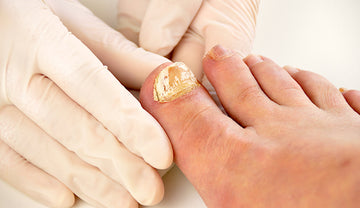NAIL FUNGUS

The Best Nail Fungus Treatment to Get Rid of Finger & Toenail Fungus Fast

If you’re one of the millions of people suffering from onychomycosis, also known as nail fungus, you’re probably looking for ways to beat this stubborn condition. Learn more about the causes, symptoms and prevention tips for onychomycosis, as well as provide an overview of the best nail fungus treatment options available. With this information in hand, you’ll be armed and ready to fight back against nail fungus.
What Is Onychomycosis?
Onychomycosis, also known as tinea unguium, is a fungal infection of the nails that may involve the toenails or fingernails. The most common type of fungus to cause onychomycosis is dermatophyte and it often begins as an infection in the skin called tinea pedis or athlete’s foot.
Dermatophytes are able to invade the nails because they have keratinases, enzymes that can break down keratin. Once these fungi invade the nails, they are difficult to eliminate because nails provide a good environment for their growth: they are warm, dark, and usually moist. Fungi can also spread from person to person very easily.
People with certain risk factors are more likely than others to develop onychomycosis. These include:
Age: Older adults are more susceptible because their nails grow more slowly and thicken with age, providing a favorable environment for fungal growth. In addition, older adults are more likely to have underlying medical conditions that can lead to onychomycosis.
Exposure to someone with onychomycosis: If you have close contact with someone who has onychomycosis, you’re more likely to develop the condition yourself. This is especially true if you share personal items, such as nail clippers or files, with that person.
Damaged nails: Injury to your nails makes it easier for fungi to penetrate them. Nails that frequently are exposed to water also are at increased risk of developing onychomycosis because dampness can damage the nail and allow fungi to grow.
Sweaty feet: Sweat provides moisture that helps fungi grow. People who wear shoes that make their feet sweat excessively (such as rubber boots) or who don’t ventilation well (such as ski boots) have an increased risk of developing onychomycosis.
Common Symptoms of Onychomycosis
Symptoms of onychomycosis vary depending on how much of your nail is affected by the fungus. The early stages of onychomycosis may be difficult to detect because the infection usually starts at the edge of your nail and spreads slowly inward. As the infection progresses, symptoms may include:
Nail discoloration: The nail may turn white, black, yellow or greenish-brown as debris builds up under your nail plate. You also may see small white spots or streaks appear on your nail surface. As the infection spreads deeper into your nail, it will begin to thicken and crumble around the edges. In severe cases, pieces of your nail may separate from its bed (onychatrophia). Your entire nail may eventually turn brown or yellow, become thickened, and develop crumbling edges. Debris also can accumulate under your infected nails, causing them to lift away from their beds (onychectomy). If this happens, eating and other normal activities could become painful.
Nail changes: In some cases, an area of redness appears around your cuticle as the infection begins. As it worsens, you’ll notice changes in how your nails look and feel: They might become thicker than usual; harden; become brittle; detach from their beds; produce a bad odor; or cause pain when walking barefoot. Severe infections could lead to permanent damage or loss of your affected nails.
If you think you might have onychomycosis, schedule an appointment with a board-certified dermatologist or podiatrist so he or she can properly diagnose and treat your condition.
Preventing Onychomycosis.
There are a number of ways that you can reduce your risk of contracting onychomycosis. These include:
Keeping your feet clean and dry. Fungi thrive in moist environments, so it’s important to keep your feet as dry as possible. This means wearing socks made from materials that wick away moisture, and changing them often if they become wet. You should also avoid walking barefoot in public places like locker rooms or pool areas.
Avoiding injury to your nails. Trauma to the nails provides an opening for fungi to enter and infect the nail bed. Be careful not to drop heavy objects on your feet, and trim your nails regularly to keep them short and free of sharp edges.
Wearing well-fitting shoes. Ill-fitting shoes can lead to a number of problems, including blisters, calluses, and ingrown nails—all of which can provide an entry point for fungi. Make sure your shoes have enough room in the toe box, and don’t wear them for extended periods of time without taking a break.
Keeping your blood sugar under control if you have diabetes. People with diabetes are at an increased risk for developing onychomycosis due to poor circulation and nerve damage in their feet. By keeping your blood sugar under control, you can help reduce your risk of developing the condition.
Treating Onychomycosis
There are a number of prescription and over-the-counter medications that can be used to treat onychomycosis. The most common medication used to treat onychomycosis is terbinafine, which is an antifungal medication. Other medications that may be prescribed include itraconazole, fluconazole, and griseofulvin. In some cases, a combination of two or more of these medications may be prescribed.
One of the more trending over-the-counter topical antibiotics that boasts being 10x more effective than other brand name treatments is Vitastem, which can produce results within 24 hours, opposed to 5 to 7 days (if ever) when compared to other medications.
Home Remedies for Onychomycosis
In addition to medication, there are a number of home remedies that can be used to treat onychomycosis. One popular home remedy is soaking the affected nails in vinegar or Listerine mouthwash. Another home remedy is applying tea tree oil or Vicks VapoRub to the affected nails. However, there is a more effective solution – Vitastem Ultra.
The bottom line on treating Onychomycosis
Onychomycosis is a fungal infection of the nails that can be difficult to treat. If you think you may have onychomycosis, it is important to see a doctor so that they can prescribe the appropriate medication. There are also some things that you can do at home to help treat the infection.
If you have onychomycosis, it is important to keep your feet clean and dry. You should also avoid sharing nail clippers or other personal items with others. In addition, there are several medications that can be used to treat onychomycosis. If home remedies don’t work, your doctor may prescribe oral antifungal medication or medicated nail polish.
While onychomycosis can be difficult to treat, there are several options available. If you think you may have onychomycosis, ask your doctor about using Vitastem Ultra as a nail fungus treatment so you can get back to living your life stress-free and fully once again.



